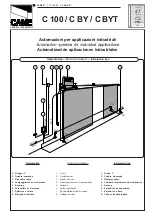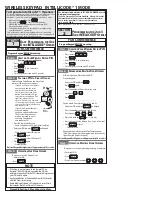
EN
9
EN
8
1. HAZARD ANALYSIS
1.1. Regulation
Installation of a motorised gate or a motor drive on
an existing gate within the framework of “Residential”
type use must be compliant with directive 89/106/
EEC concerning building products.
The reference standard used to check this compliance
is EN 13241-1 which refers to a framework of several
standards including EN 12445 and EN 12453 which
specify the motorised gate safety methods and
components to reduce or completely eliminate hazards
to people.
The installer must train the end user on the correct
operation of the motorised gate, and the trained
user must train the other people likely to use the
motorised gate, using this guide.
It is specified in standard EN 12453 that the minimum
protection of the gate’s primary edge depends on the
type of use and the type of control used to set the
gate in motion.
The gate motor drive is a press control system, i.e.
simply pressing one of the control parts (remote
control, key selector, etc.) sets the gate in motion.
This gate motor drive is equipped with a force
limiter which complies with appendix A of EN 12453
standard, within the framework of use with a gate
that is compliant with the specifications given in this
chapter. The specifications of EN12453 standard
therefore enable the 3 following use cases, as well
as the minimum levels of protection:
• Press activation with visible gate
- Force limiter only.
• Press activation with non-visible gate
- Force limiter and 2 pairs of photocells to protect
the gate’s opening and closing.
• Automatic control (automatic closure)
- Force limiter and 1 pair of photocells to protect
the gate’s automatic closing
The flashing light is an essential safety component.
The photocell type safety devices and their correct
operation must be checked every six months
1.2. Specifications of the gate to motorise
This motor drive can automate swing gates up to
2.50m
wide and
2.80m
high and weighing
250kg
.
These maximum dimensions and weights are for an
openwork-type gate and for use in an area that is
not very windy.
For solid gates or a use in an area
with significant wind speed, it is necessary to
reduce the maximum values indicated above
for the gate to be motorised.
1.3. Safety checks on the gate
The motorised gate is strictly for residential use. The
gate must not be installed in an explosive or corrosive
atmosphere (presence of gas, flammable smoke,
vapour or dust).
• The gate must not have locking systems (latch,
lock, bolt, etc.).
• The hinges of the gate must be on the same axis
and the axis must be vertical.
• The posts supporting the gate must be strong
and stable enough so that they do not bend (or
break) under the weight of the gate.
• Without the motor drive, the gate must be in good
mechanical conditions, correctly balanced and
open and close without friction or resistance.
• Greasing the hinges is recommended. Check that
the fastening points of the different components
are in locations that are sheltered from shock and
that the surfaces are solid enough.
• Check that the gate does not have any part
protruding from its structure. The central stop and
side stops must be appropriately fastened so as
not to give way under the force exerted by the
motorised gate.
If installation does not correspond to one of the
cases shown in the guide, contact us so that we can
provide all the components necessary for proper
installation with no risk of damage.
The motor drive cannot be used with a driven part
that has a door.
C - INSTALLATION









































